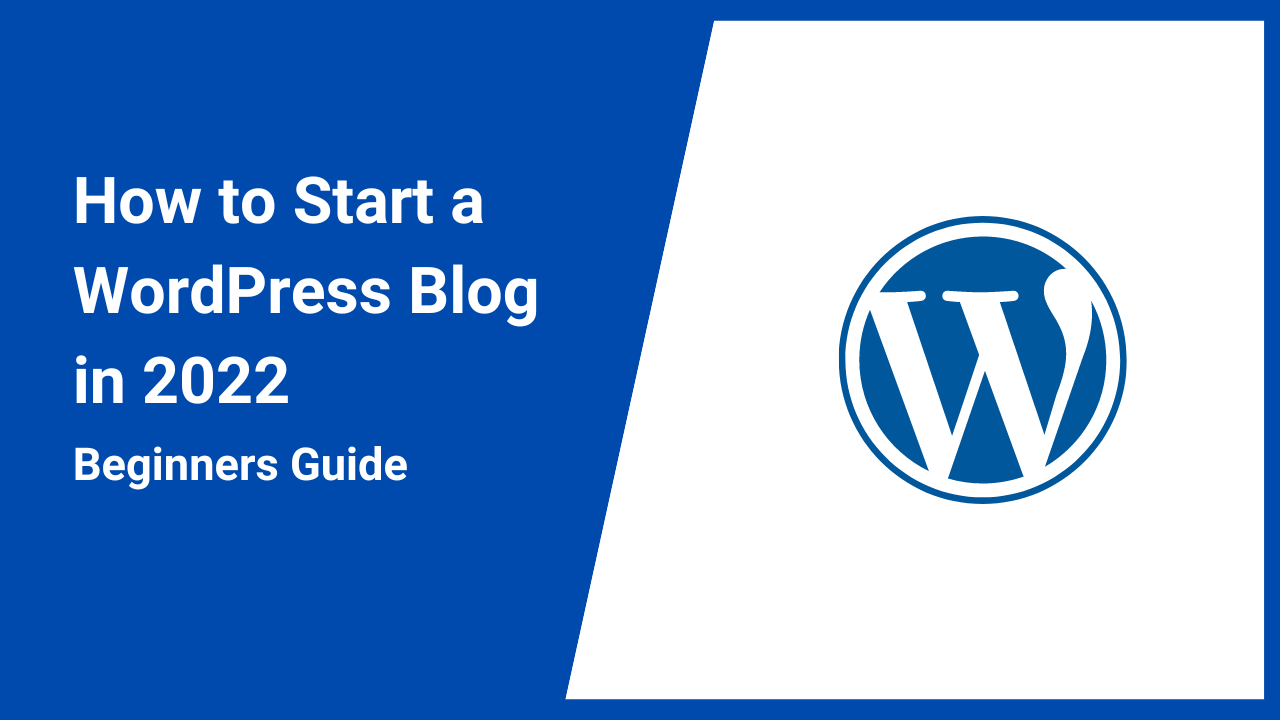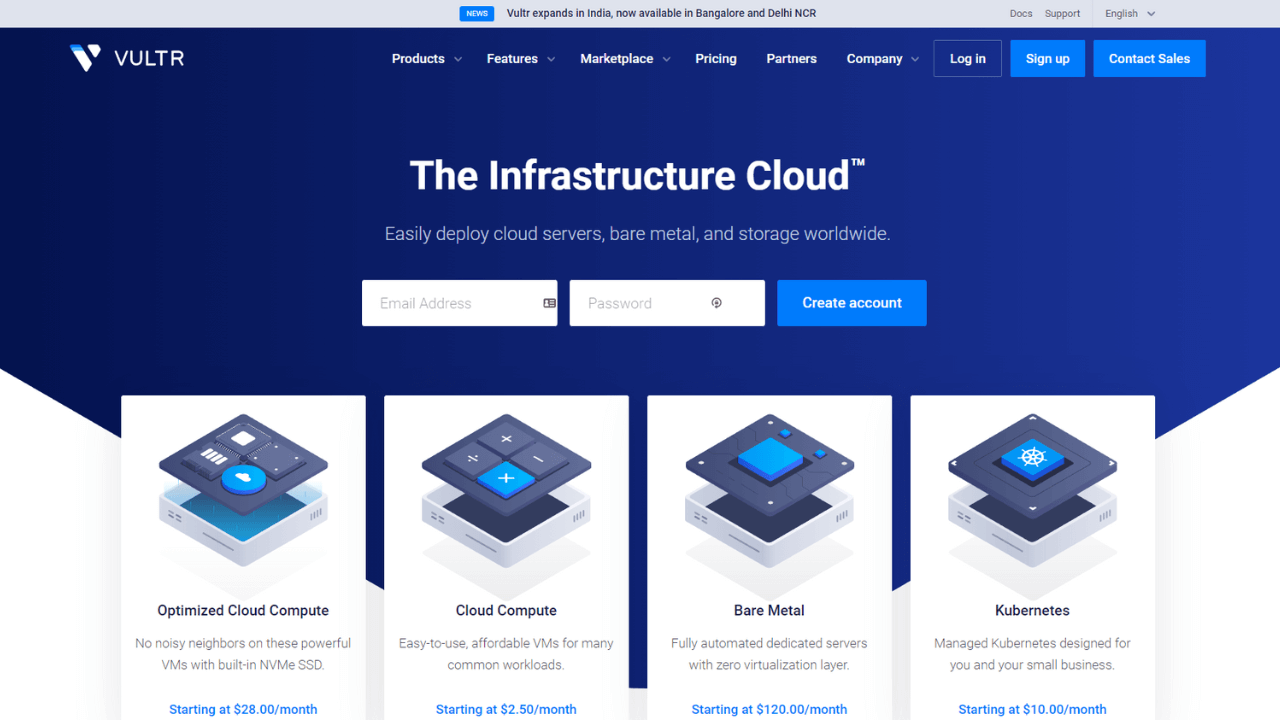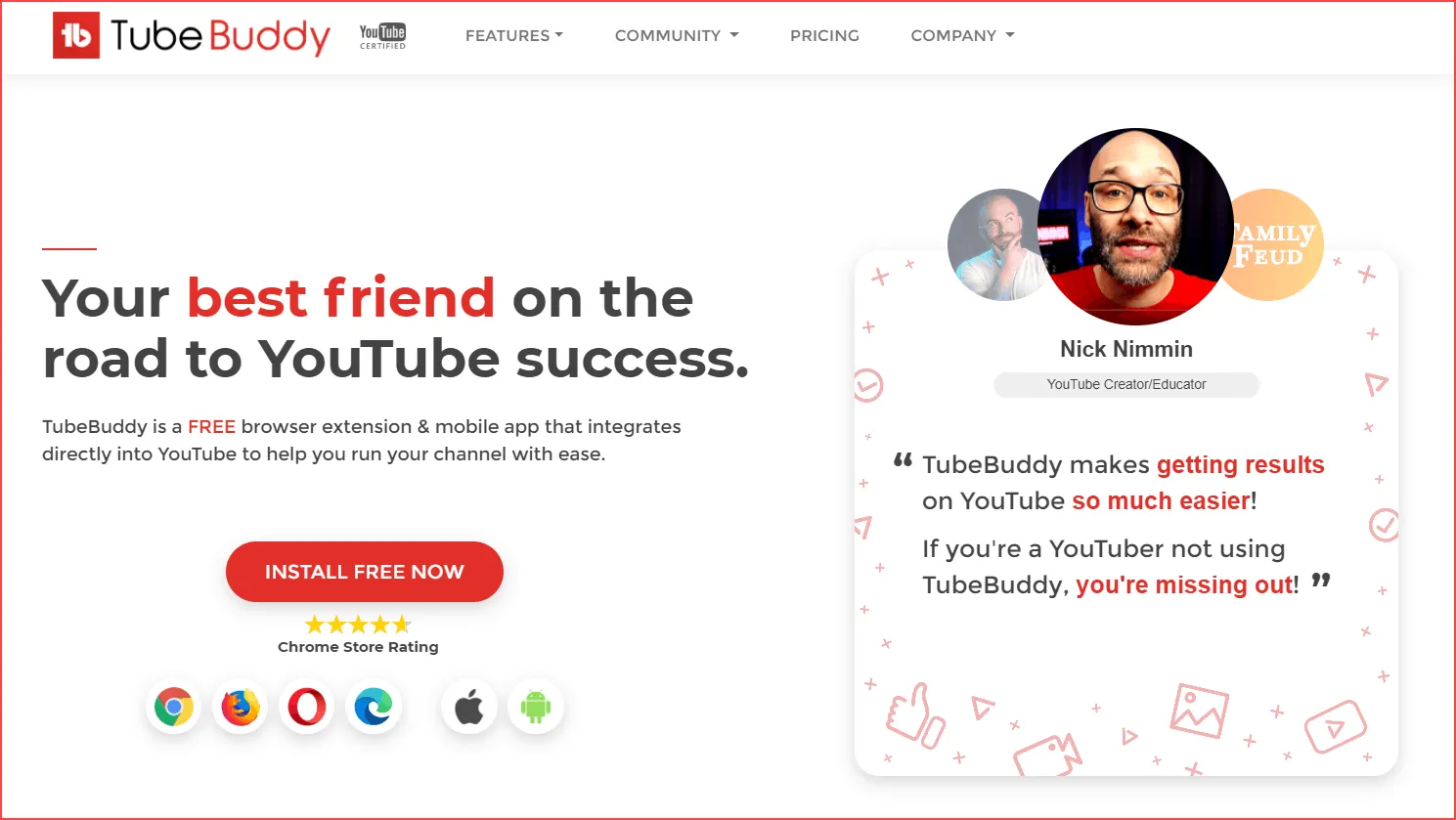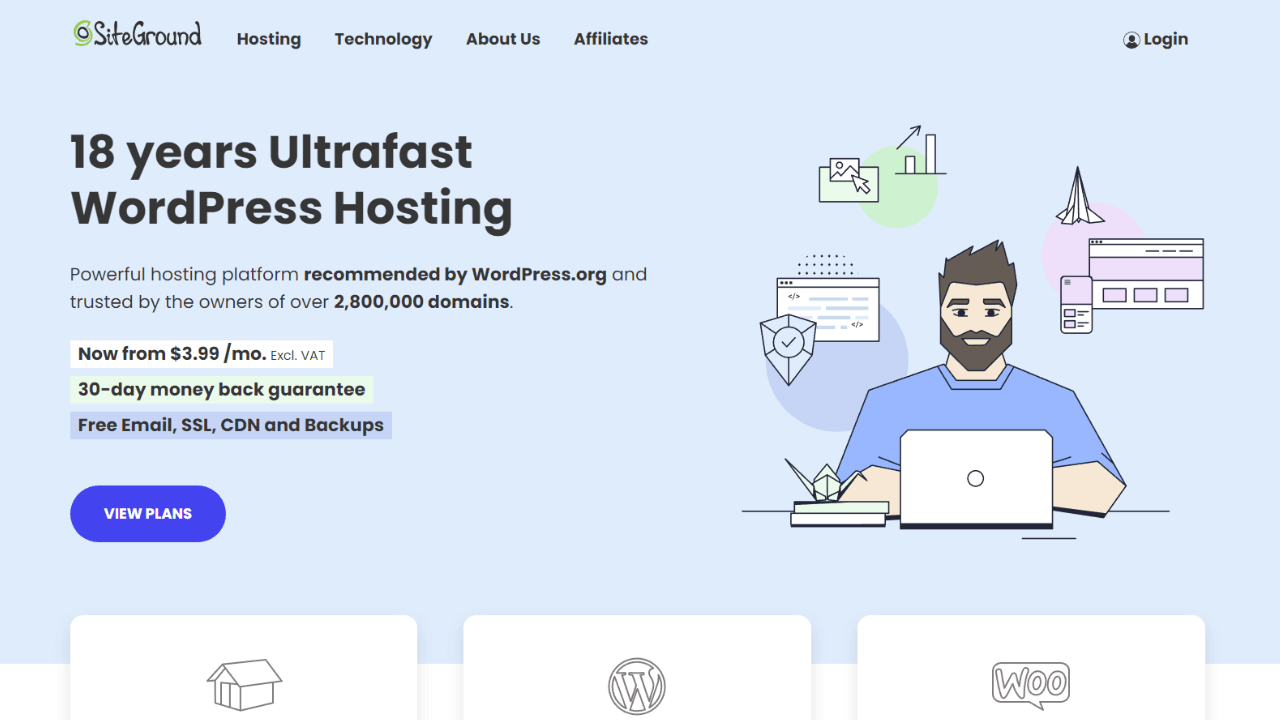Are you interested in making money online? Want to profit from blogging? But have yet to learn how to build a blog.
Here is the appropriate tutorial: This post will demonstrate how to create a WordPress blog.
Additionally, it is surprisingly simple to set up a free blog. Therefore, it may be completed in less than 15 minutes.
We will show you every step necessary to create a blog using self-hosted WordPress. And we’ll do so with a plethora of screenshots and easy-to-follow directions. Start a blog today!
How to create a blog: what you’ll need
If you wish to create a blog, here’s the entire process step-by-step:
- Register for web hosting (we recommend Bluehost).
- Choose a domain for your blog.
- Install free WordPress blog software.
- Log in and write your first blog post.
- Change the Appearance of your blog by selecting a theme.
- Install several necessary plugins.
- Don’t forget marketing.
Each of these stages will be covered in detail in the following sections, but you should know that neither requires in-depth technical knowledge. Yes, it is possible to figure out how to create a blog on your own!
Once your free WordPress blog is up and running, you’ll certainly want to begin posting and modify its Appearance and functionality (e.g., completely changing your header or revamp your homepage). To help you do that, we’ll also show you how to:
- Using WordPress’s editor, compose your first blog post.
- Change the Appearance of your free WordPress blog with a “theme.”
- Using “plugins,” you can add functionality to your blog.
You can follow this instruction if you know how to utilize social networking sites like Facebook and Tumblr and have a general comfort level with “web stuff.” We guarantee!
Step 1: Purchase hosting and your domain name
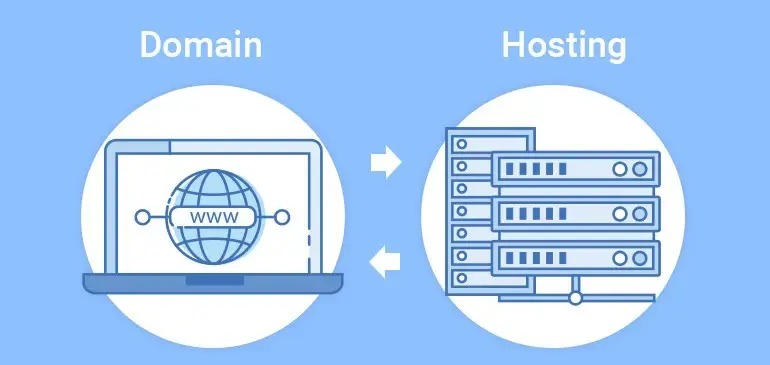
Have you already chosen a niche for your blog? Two things are necessary to make your free WordPress blog available to people around the world and or ready for search engine optimization
- Hosting – this is the engine that powers your site. While you don’t “see it,” every single website on the internet has a hosting provider powering it.
- Domain – this is your blog’s permanent address. For example, ours is toptoolsonline.com.
Some Tips for Choosing a Domain Name for Your Blog
- Keep it short. Fewer characters reduce the user’s burden and the possibility of typographical errors.
- Should you use your own name or choose a more wide subject? The answer should be simple. Is the blog about you, or are you attempting to establish a separate brand?
- Make it easy to type. You do not want other websites to receive your visitors if someone enters in the incorrect URL.
- Consider using broad keywords. Top-level topics like “cooking” are wonderful, but you must tie them to more specific ideas.
- Make it easy to pronounce. There is no need to confuse folks with difficult spellings or clever typos.
- Ensure that the name of the blog makes sense. It needs to be user- and Google-friendly!
- Avoid using numbers and hyphens. This causes confusion and makes it difficult to explain the domain to others.
- Do not utilize the brand names or trademarked slogans of other companies. They will pursue you and destroy you!
Include, if feasible, terms that connect to your main theme. For instance, if you intend to write about recipes, you may choose to use the words recipe or cooking. Don’t force it, but incorporate crucial terms wherever possible.
Create a shortlist of acceptable domain names and choose the best option.
Avoid overthinking. The goal is to act immediately and build momentum. New pages do not immediately rank on Google, so the sooner you begin, the better.
Once your domain name is prepared, it is time to pick a web host. You can buy blog hosting and a domain at the same time, so don’t worry too much about the specifics just now. However, before you can do so, you must select a WordPress host. Due to the popularity of WordPress, there are a vast variety of WordPress hosts.
We’ve personally tested the performance and reliability of many hosting companies. Considering the outcomes of all these studies, we can recommend Bluehost to new bloggers in the WordPress world.
Here’s why:
- It’s inexpensive. For the first 12 months, you may host your website for the price of a small latte per month, or $2.75 per month.
- When you sign up, a free domain name is provided. This relates to affordability; your own domain would normally cost $10 or more.
- WordPress can be readily installed. You can launch the WordPress program and have a functioning blog with only a few clicks. No technical skills required!
- It provides sufficient performance to get you started. When you’re just getting started, Bluehost provides plenty of performance to keep your website loading quickly.
Bluehost will charge you approximately $33 for the entire year to host your blog, which includes your free domain name. In addition, a 30-day money-back guarantee is provided.
That’s about as cheap as it’s going to get if you want to create a WordPress blog.
Examples of Hosting Providers
Here are some reputable hosting companies. You can review their plans and services and select the one that best suits your needs.
- Bluehost
- SiteGround
How to sign up for WordPress hosting at Bluehost
Click here to visit Bluehost and activate their $2.75/month special offer. Then, click the “Start Now” button. You will be transported to the Bluehost plans page.
We recommend the cheap Basic plan for novices because it provides ample power for your budding blog. To initiate the procedure, click the SELECT button.
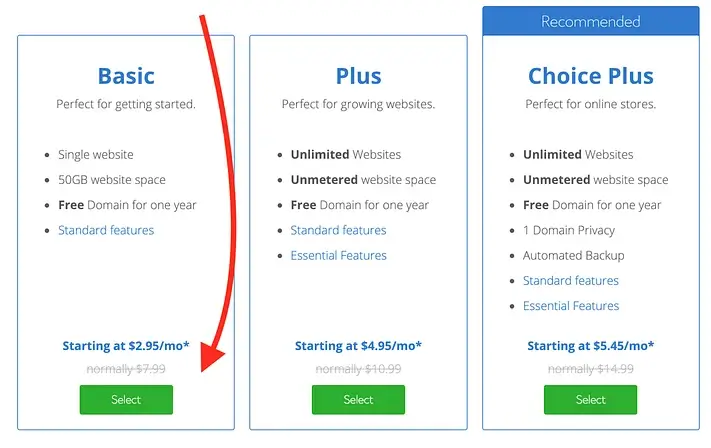
On the next screen, enter the domain name you wish to use for your blog and click Next. Your blog’s name should accurately reflect the extent of your interests and be simple. Bluehost provides a FAQ dedicated to the subject if you have questions. Remember – you get this for free:
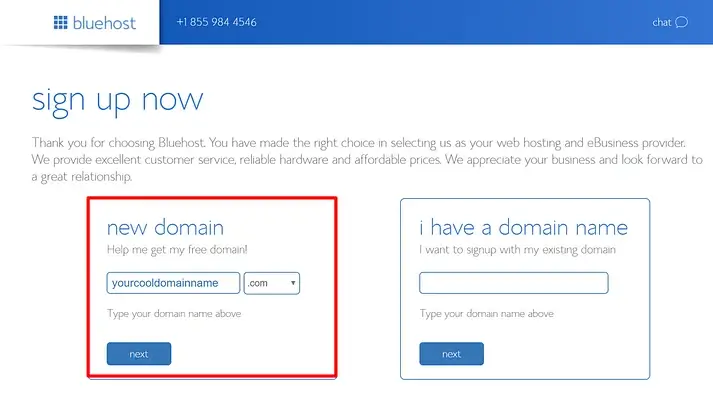
One-click brings you to the last screen, where you must enter your basic account and billing information:
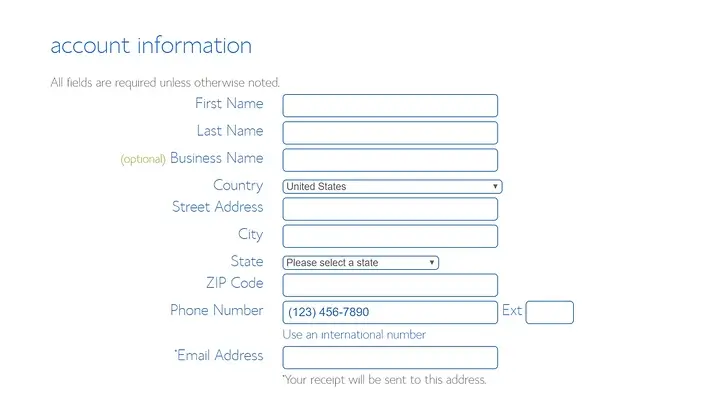
As you scroll down, a Package Information section will appear at the bottom. Here, you can select the number of years of hosting service to purchase and any desired add-ons. While Bluehost will automatically choose some of these add-ons, you can safely deselect them:
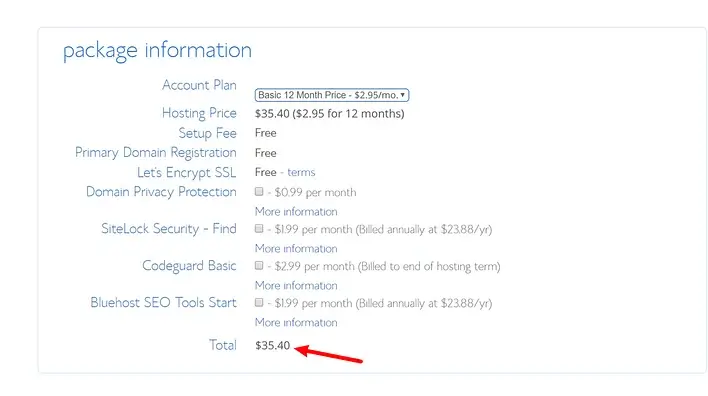
You should pay approximately $35 for a domain name and one year of hosting.
After entering all the required information, click SUBMIT at the bottom of the page to complete your purchase.
That’s all right! Install all needed for your new blogging platform.
Step 2: Install the free WordPress software
Unsurprisingly, if you wish to start a WordPress blog, you will need to install the WordPress software.
We know this may sound frightening, but we hope you’ll be pleasantly surprised by how simple it is to install WordPress.
When you completed the signup process in the preceding step, Bluehost should have sent you an email with instructions on how to log in to the Bluehost Customer Area.
Go ahead and log in to Bluehost.
Bluehost provides a straightforward wizard that walks you through the process of installing WordPress on your new site as soon as you log in for the first time.
Not seeing the setup assistant? Still, Bluehost makes WordPress installation really simple. Simply navigate to My Sites and select the Create Site button to initiate the wizard:
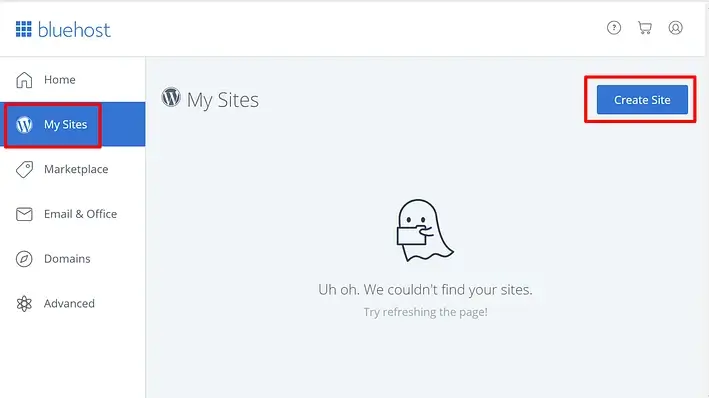
Then, you’ll be able to enter the site’s name and the username/password you’ll use to administer your WordPress blog:
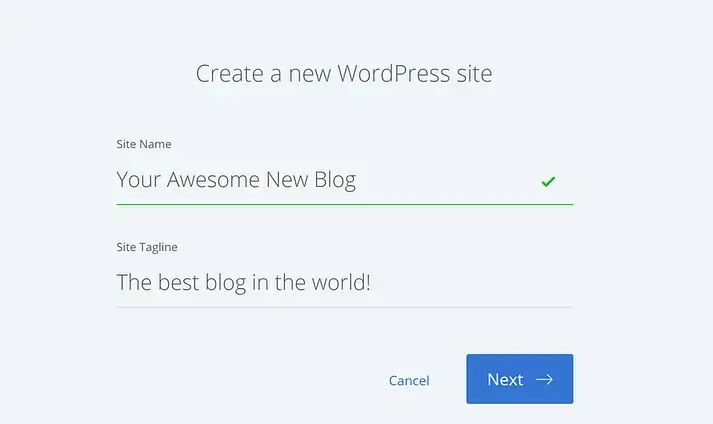
After the installation is complete, you can visit your new blog’s dashboard at yourdomain.com/wp-admin.
Step 3: Go ahead and write your first blog post – you earned it!
Having learnt how to build a WordPress blog, you are likely eager to start blogging!
In a moment, we’ll teach you how to modify the Appearance and functionality of your blog. However, let’s first discuss how simple it is to begin blogging on your own website.
When you initially log in to the WordPress dashboard for your site, you should see the following screen:
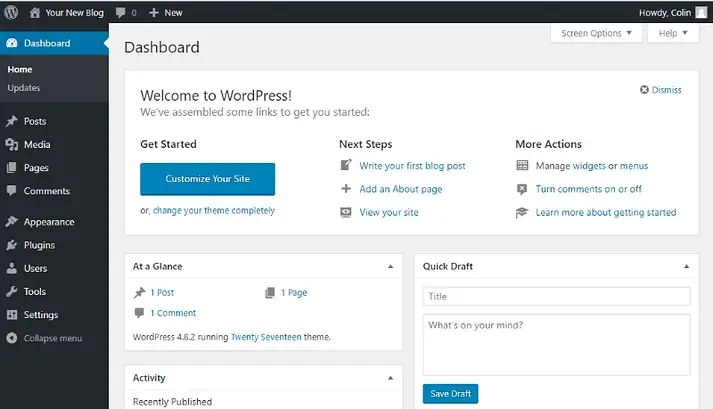
To write a blog post:
- Hover over Posts
- Click Add New
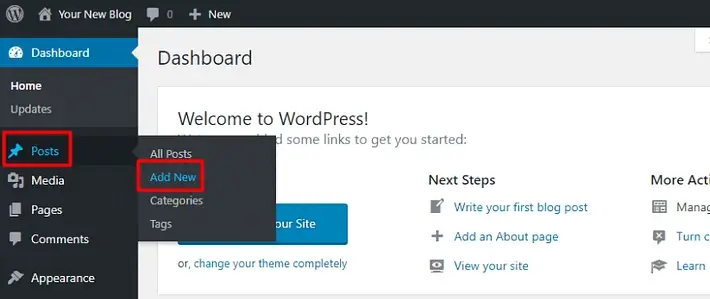
This will activate the WordPress Editor, which allows you to compose blog entries with an extremely intuitive block-based architecture.
To add text, simply click and start typing. For additional content, such as a picture or YouTube video embed, you can add new “blocks.”
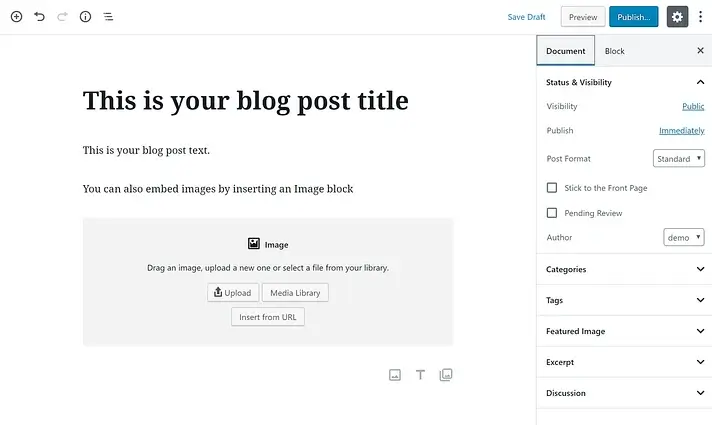
You may also add pages to your site (such as an About Me page) and search for themes and plugins to customize the Appearance and functionality of your WordPress blog.
Step 4: Here’s how to change how your blog looks.
When you create a WordPress blog, you gain access to its extensive library of themes and plugins, which is one of the most significant advantages. Here’s a quick overview of the two:
- Themes – these change how your free WordPress blog looks
- Plugins – These add functionality to your blog
The former will be covered in this section.
When you create a WordPress blog, a theme is automatically activated. This is either the WordPress default theme or the theme you selected during the Bluehost Setup Wizard.
However, there are many more blog themes available for WordPress websites (many of which are open source, much like WordPress), so you are by no means limited to the little selection that Bluehost displays initially.
Where to find WordPress themes for your blog
When selecting a WordPress theme, you must choose between free and paid options. There is no intrinsic distinction between the two. However premium themes typically offer more intricate designs and functionality.
To find free themes, the best place to search is the official WordPress.org theme directory.
To find premium themes, you must adopt a larger strategy. Some viable alternatives are:
- ThemeForest – a big directory of premium themes.
- …
- …
If you like to bypass the search process, we have also compiled a list of the most popular and best free WordPress themes.
How to install a WordPress theme
Once you’ve discovered a theme you adore, WordPress makes it simple to implement it on your website.
Here’s how:
- Hover over Appearance
- Select Themes
- Click the Add New button
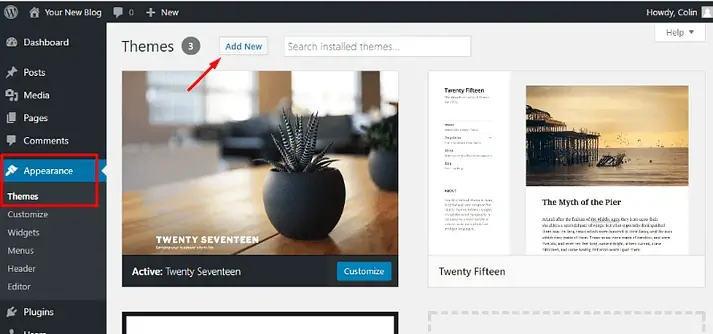
If you selected a free theme at WordPress.org, search for it by name and then click Install.
If you purchased a premium theme, click the Upload Theme button and upload the ZIP file you should have received when you purchased the theme.
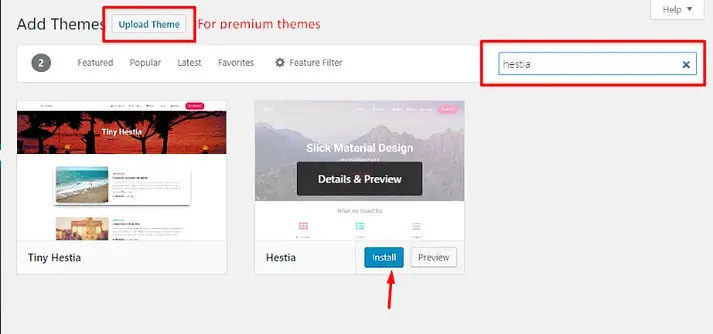
Click the Activate button after installing your theme to make it live on your website.
How to further customize your WordPress theme
You can use the WordPress Customizer to further adjust your theme as if it were a template (which is something resembling a website builder). This interface enables you to improve your online design by modifying your theme without knowing HTML or code.
You can access it by going to Appearance → Customize:
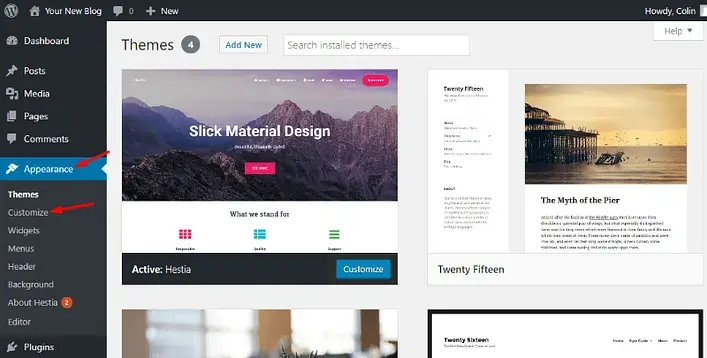
Depending on the chosen theme, the left sidebar may include various choices. In general, though, you can:
- Make changes by using the options on the left.
- See a real-time preview on the website preview on the right.
- Make your changes live by clicking Save & Publish.
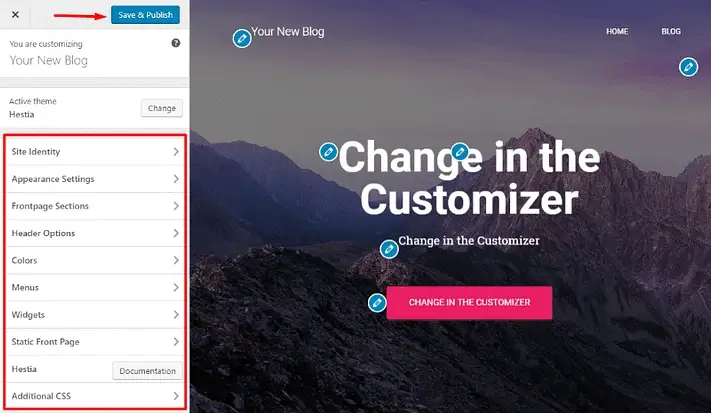
Step 5: Here’s how to add functionality to your blog.
While themes are primarily concerned with aesthetics, plugins help you add functionality to your free WordPress blog.
When you initially start a WordPress blog, you may essentially only publish blog posts and create pages.
Here is our expert pick of the best WordPress plugins that you should check out.
- Backup – UpdraftPlus is the best WordPress backup plugin. You must create regular backups of your website in case something goes wrong.
- Security – Sucuri Security is a free WordPress security scanner.
- Performance — To speed up WordPress, we recommend using either WP Rocket (paid) or WP Super Cache (free).
- Email Marketing – As an email marketing service, we recommend Constant Contact or HubSpot. We propose using the OptinMonster free plugin to generate high-converting popups, scroll boxes, and calls to action to increase the number of email subscribers.
There is probably a plugin for every conceivable feature. The WordPress community provides over 50,000 free plugins and thousands of paid plugins.
How to install WordPress plugins
- Go to Plugins → Add New
- If you chose a free plugin at WordPress.org, search for the plugin by name and click Install Now.
- Click the Upload Plugin button and upload the ZIP file you should have received when you purchased the premium plugin.
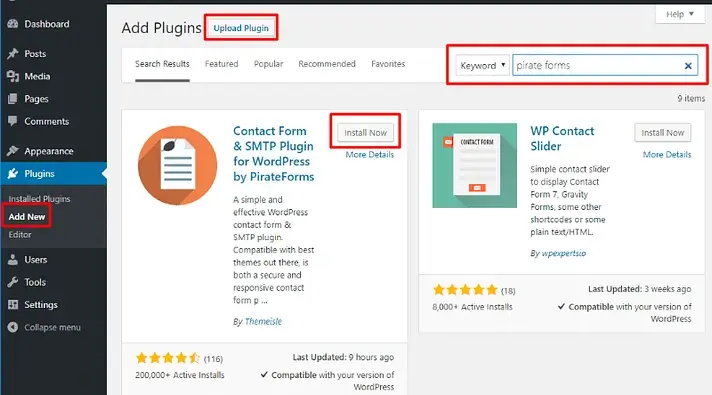
Make sure to Activate the plugin after installing it.
You can always manage your existing plugins by going to the Plugins tab:
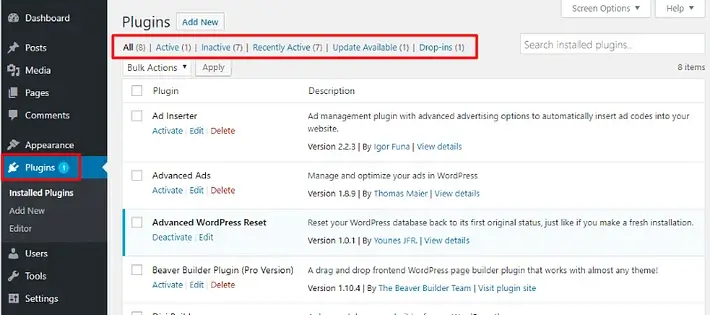
Next Steps
Once your blog is up and running, you may choose to consider improving it and earning money in the process.
Make Money
There are numerous ways to monetize your site. We’ll concentrate on two principal methods:
Ads — or banner adverts- are a great way to earn money on your blog. This type of promotion entails posting advertisements on your blog’s pages. There are two ways to profit from advertisements. One method is CPC (cost per click), where you are compensated for each ad click. The alternative is CPM (cost per mile, or more often cost per thousand impressions), where you are paid a set amount for every 1000 times your banner is viewed.
Affiliate marketing – is the process of earning a commission through the promotion of other people’s products. There are other sorts of affiliate marketing, but the one most appropriate for a blog is text-based product promotion that includes a unique, trackable link. If a buyer clicks on the link and purchases the product, you will receive a commission.
This is a comprehensive tutorial on monetizing your WordPress site.
Get More Visitors
Getting more visitors is crucial to the blog’s success. The preceding strategies of producing money will be more effective if you have more visitors. Several factors can affect the number of visits to your blog, and they are all related to its promotion.
One method for ensuring that people visit your blog is to ensure that they are aware of its existence. This involves advertising your blog via social media, email marketing campaigns and paid search engine and social media advertisements.
- Social media interaction is important. You get access to millions of individuals, who may in turn, share your blog with their friends. You want readers to be aware of you. Therefore make it simple for them to share your blog by including social media buttons.
- Email marketing campaigns can be a consistent reminder of your blog. Prepare a contact form, set it on your blog, create a newsletter, and send it out; you’ll quickly witness a significant boost in the number of your site’s visitors.
- Paid advertisements are not the cheapest way, but they are sometimes the simplest. Obtain paid advertisements and ensure that your blog is visible when visitors search for certain terms or browse specific themes.
SEO Optimization
Search Engine Optimization (SEO) is the art, nay, the science of ensuring that your content appears first on the results page of a search engine. Why? Because individuals tend to select the top results. The higher you rank, the more likely they are to visit your blog after clicking on your link.
Companies use SEO consultants to ensure the success of their websites, but blog owners may do some things to optimize their SEO.
- Meta Titles & Meta Descriptions – these are the titles and descriptions that appear on the search engine results page. Therefore, you must ensure that they convey the topic of your site and are interesting to the reader.
- Keyword Research – When writing your blog, be careful to conduct keyword research to see what people are seeking when searching for a particular topic, and then include these keywords in your blog.
- User Experience — Several aspects influence the user experience, including the blog’s design, its navigation, its loading speed, and whether or not it is optimized for mobile devices.
- Competition — Check out your top-ranking competitors and try to understand why they are doing better than you. Get inspiration from them and improve your blog.
- Value – Lastly, but most importantly, always consider the value you can provide to your users and strive to provide them with the finest experience possible.
Conclusion
Now that you have a blog topic, domain, and hosting, it’s time to get down to business: sharing your material with the world.
Everything begins with your passion. You are on the right track as long as you devote time to writing and inject your knowledge and passions into your postings.
Regularly publish content as you begin to create a following. So, each new wave of readers is greeted with an abundance of your writing to consume.
You may really begin to attract your audience if you take a little more time to develop each blog post.
Good luck with your new WordPress blog. Leave a comment below if you have any questions.

